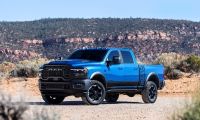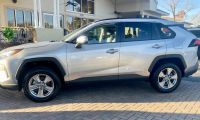A rift has opened in the electric vehicle world. On one side are battery-electric vehicle (BEV) EVangelists that feel any green vehicle technology but the one they prefer should be banned, ignored, or disparaged. On the other side are drivers looking for any technology that makes a meaningful impact on vehicle emissions in a cost-effective way that works well for them.
One favorite target of BEV-only crusaders is the plug-in hybrid-electric vehicle (PHEV). Let’s look at some of the common myths employed by those who wish to cast one of the world’s best passenger vehicle emissions-reducing technologies in a bad light.
A little background on EVs. A battery-electric vehicle (BEV) uses just a battery-powered motor to propel the vehicle. A plug-in hybrid-electric vehicle (PHEV) is one that has an electric motor for all-electric driving, but also a gas engine for use when hybrid-electric driving makes more sense, or when the all-electric mode is unavailable due to its traction battery’s state of charge. Examples of battery-electric vehicles are the Chevy Bolt, the Tesla Model 3, Tesla Model Y, or Ford’s New Mustang Mach-E. Examples of PHEVs include the Toyota Prius Prime and RAV4 Prime and the upcoming Ford Escape PHEV. Some owners include the discontinued Chevy Volt in this group.
Myth One - PHEVs Have “All The Problems” of an ICE Vehicle
The most common myth that BEV EVangelists use to denigrate PHEVs is that the PHEV carries with it the baggage of old-school internal combustion engine (ICE) problems and hassles. In particular, high maintenance and repair costs, and low reliability.
This myth has been disproven by studies conducted by Consumer Reports. Owners report that PHEVs on sale today have similar cost of ownership advantages to BEVs when compared to older ICE vehicles. In fact, the PHEVs come out ahead in some cases. These studies were not theoretical. They are based on owner-reported costs for maintenance and repair. Our evaluation of the required maintenance of the Tesla Model Y vs. the Toyota RAV4 Prime reached the same conclusion based on a tally of the required maintenance each vehicle’s manufacturer recommends.
The misconception stems mainly from BEV fans preferring to ignore the advances that have been made in modern PHEV vehicle design. Most of the failure points and maintenance-intensive parts from traditional ICE vehicles have been designed out of modern PHEVs. For example, there are no drive belts in a RAV4 Prime. Nor is there a timing belt. Toyota also eliminated the starter and alternator, and all modern vehicles use electronic steering, rather than hydraulic.Toyota’s all-wheel drive system is similar in its design to how BEVs with AWD operate. There is no front to rear driveshaft, saving space, weight, and cost. Over the years that Toyota has built PHEVs, they have proven very reliable. By contrast, Tesla’s battery-electric vehicle reliability scores are mixed at best.
To point out the “silliness” of an internal combustion engine, some BEV fans will ask “How many parts are in an internal combustion engine?” The point is to imply these are all likely failure points. Yet Tesla’s most modern battery has 960 individual cells. Each of which has multiple parts.
Myth Two - Once the Battery Runs Out PHEVs Are Typical ICE Vehicles
One way BEV fans downplay the effectiveness of PHEVs in reducing energy use and emissions is by claiming that once the traction battery is depleted they are “just normal ICE vehicles.” This is incorrect on many levels.
First, the traction battery is never fully depleted. All modern hybrids of all types reserve battery power for starts and to operate their electric all-wheel drive system. By using energy recapture and in some cases, intelligent charging via the engine, PHEVs don’t revert to being your dad’s ‘72 Chevelle when the traction battery is depleted. Rather, they operate as ultra-efficient hybrid-electric vehicles with efficiency advantages of 30 to 50% beyond traditional vehicles in their class. For example, when a Prius Prime is operated as a hybrid, its MPG rating is 54 MPG. When we tested the RAV4 Prime and purposely operated it without its traction battery to gauge its efficiency as a hybrid, it returned a 45 MPG result.
Myth Three - Owners of PHEVs Don’t Charge Them, Thus They Are Not Really Green
This myth is so far from reality it is hard to know where to begin. Let’s start with the many PHEV owners’ groups where owners show off their percent EV vs. gas usage. Or the posts that brag about not having to buy gas for weeks or months. The fact is, most owners of PHEVs like the Volt or RAV4 Prime will tell you that the vehicle is an electric vehicle in their day-to-day use. Yet, the plug-in hybrid technology allows these drivers to also use the vehicle on occasional long trips, eliminating the need for a second vehicle.

Myth Four - PHEVs Are More Polluting Than Carmakers Claim
This myth was started by a European advocacy publication whose goal is to end the use of liquid fuels in vehicles. A worthy goal, but the claim deserves scrutiny.
First of all, in the United States automakers do not make pollution or MPG claims. They only report what the EPA testing mandates provide as results. Automakers will sometimes make predictions about efficiency or emissions based on EPA-format testing, but the EPA and the EPA alone rates US-model vehicles for emissions and efficiency.
Automakers do participate in testing, and some have cheated on MPG-related issues in the past. Humans are often tempted to cheat for financial gain. In the case of US-spec vehicles, automakers don’t advertise any efficiency or emission claims other than what the EPA’s testing mandate will yield. Torque News maintains contacts at the EPA. Our primary contact for technology at the EPA drives a PHEV. This person is not doing so because there is some kind of trick involved.
Like all good myths, there is a nugget of knowledge behind this myth. Anti-liquid-fuel advocacy groups point to the way hybrids and PHEVs operate as a fatal flaw. They know that gas-powered vehicles require catalytic converters to reduce polluting emissions. These converters need to be hot in order to function properly. The anti-PHEV folks claim that since the PHEV's engine cycles on and off, the converters are never properly heated, thus emissions are higher than “claimed.”
The problem with this false narrative is that Toyota addressed this technical challenge before PHEVs arrived. For over a decade, hybrids like the Prius have had heat rapture technology to help warm engines and catalytic converters more rapidly than conventional vehicles. They also store this heat so a few engine cycles on a short trip don’t negate the ability of the converters to work properly. This is why the Prius earns the same perfect 10/10 EPA smog ratings as the all-electric Chevy Bolt.
In the RAV4 Prime PHEV, Toyota employs multiple technologies to ensure its gas engine operates cleanly. One of the most pertinent to this story is Warm Up Control. This technology uses an electric water pump and electric thermostat, two technologies not found in conventional engines. Employed when the engine is initially started, this system enables the RAV4 Prime to purify emissions at an earlier stage than other vehicles.
This myth also suffers from a logic problem. If the driver of a RAV4 Prime covers 40 miles in a daily commute and uses only electricity, there are zero tailpipe emissions. If another RAV4 Prime driver covers 60 miles and uses a cold engine for part of the trip, which is the emissions standard based on? Is it based on 20 miles of gas operation alone? Why would or should it be? We will let the EPA’s perfect 10/10 emissions score the RAV4 Prime earns from the EPA answer that question.
Myth Five - Once Batteries and Charge Rates Improve, PHEVs Lose Their Appeal
Battery technology has not solved the problem of EV range anxiety because the problem isn’t a fixed number. The Nissan Leaf’s range has tripled in ten years as a result of better batteries. Yet, Leaf sales went down.
The fact is, if battery range and costs improve by 50%, all types of EVs get better, including PHEVs. In the case of a RAV4 Prime, if this occurred the vehicle would have a range of 63 miles on one charge. At that point, why would anyone need or want a battery-only vehicle? The Prime would satisfy nearly everyone’s single-day needs as an EV, yet it could also go on long uninterrupted trips and never need to worry about charging hassles. As you can see, the attractiveness of PHEVs rises with improving battery technology, rather than it diminishing.
The same arguments also point to PHEVs as benefitting from faster charging technology. PHEVs can already charge from empty to full overnight using a standard 115 V outlet. If battery charging speeds improve by a whopping 2X, that will still not be true for BEVs.
In America, the US government and individual states operate diesel-burning commuter rail systems all over the map. Nearly all homes in America above the Mason-Dixon line are warmed by fossil fuels. Much of the electricity we generate is from fossil fuels. All of the aviation industry is fossil-fuel powered. The massively-polluting container ships that haul EVs from manufacturing locations to places of use are among the most carbon-intensive machines ever built. All of America’s freight is transported by diesel trucks and diesel trains. Vilifying an effective green passenger vehicle technology because it is imperfect in its current state or not one’s preference seems crazy. Particularly when the myths used to cast PHEVs in a poor light are so easily proven baseless.
John Goreham is a long-time New England Motor Press Association member and recovering engineer. John's interest in EVs goes back to 1990 when he designed the thermal control system for an EV battery as part of an academic team. After earning his mechanical engineering degree, John completed a marketing program at Northeastern University and worked with automotive component manufacturers, in the semiconductor industry, and in biotech. In addition to Torque News, John's work has appeared in print in dozens of American newspapers and he provides reviews to many vehicle shopping sites. You can follow John on TikTok @ToknCars, on Twitter, and view his credentials at Linkedin
Image courtesy of Kate Silbaugh.













Comments
I have owned my Prius Prime
Permalink
I have owned my Prius Prime since 2017. All your 5 point were true then and true now. I fill up with non-ethanol gas because sometimes I go eight or more months without needing a refill. What a perfect car me!
I do think the PHEV and
Permalink
I do think the PHEV and Hybrid technology will help reduce emissions as a stepping stone until battery technology becomes viable for quick charging and long range. The RAV4 PHEV has a 18.1 kWh battery compared to a BEV ranging from 54 to 82 kWh. If the EV range on the RAV4 Prime meets your daily drive on pure EV, you can make about 3 RAV4s in comparison to 1 BEV.
3 families not having emissions vs 1 family definitely helps.
It also bridges the ICE to BEV transformation.
Well said LSFT. The truth
Permalink
In reply to I do think the PHEV and by LSFT (not verified)
Well said LSFT. The truth that the battery capacity needs of a PHEV enables many more green vehicles by comparison to one big BEV battery is hard to ignore.
We have a Prius Prime and a
Permalink
We have a Prius Prime and a Rav4 Prime. We have solar power. We are getting 300 mpg and 150 mpg. I do plug in at work. So most of our driving is electric. Love the Toyota product. Cannot go wrong.
The article discusses…
Permalink
The article discusses reliability in terms of vehicle technology, BEV vs PHEV. I disagree with that analysis. The same data can be used to make the claim that established automobile companies, such as Toyota, make more reliable cars than new car companies, such as Tesla, that do not have experience and culture that focuses on reliability. Once Toyota makes a pure BEV, I'm certain it will be as reliable as my RAV4 Prime.
Pagination